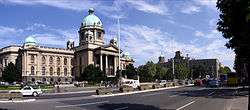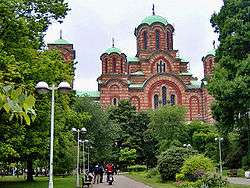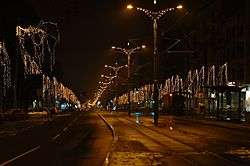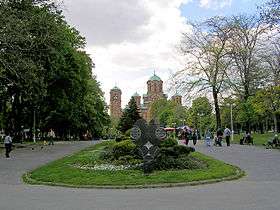Bulevar kralja Aleksandra
Bulevar kralja Aleksandra (Serbian Cyrillic: Булевар краља Александра; meaning "King Aleksandar Boulevard" or "Boulevard of King Aleksandar") is the longest street entirely within the urban limits of Serbian capital Belgrade, with length of 7.5 kilometers.[1] Known for decades after World War II as "Bulevar Revolucije" (Boulevard of the Revolution), it is so distinct in the Belgraders' hearts and minds that they simply refer to it as the Bulevar, although there are 20 boulevards in Belgrade.

Location
Due to its length, Bulevar stretches through four out of eight urban municipalities in the old section Belgrade: Stari Grad, Palilula, Vračar and Zvezdara, in which the main part of the Bulevar is located. Starting at the Square of Nikola Pašić, it goes for the most part in a south-east direction, curving only near the end, in the neighborhood of Mali Mokri Lug, after which the Bulevar extends into the road of Smederevski put, which connects Belgrade with the city of Smederevo.
History and names
Location of the boulevard was always important for the traffic. In Roman period, it was a sarting section of the 924 kilometers long Via Militaris, which connected Singidunum and Constantinople, and in more local terms, Singidunum with fortresses and settlements along the Danube border of the Roman Empire, like Viminacium. Built in the 1st century AD, the road was six meters wide, with rows of shops, forges and arsenals, while Romans were buried along the road in stone sarcophagi. Archeological remnants of the Roman road can still be seen below the “Depo”, former depot of the city’s public transportation company. Majority of boulevard's course is part of the “Ancient Singidunum” archeological locality.[2] In Ottoman period, Turks built a major cemetery in the lower part of the modern boulevard, spreading from Batal mosque (location of the modern House of the National Assembly of Serbia) to Tašmajdan. [2]
In the mid 18th century, route of the Bulevar was a famed Carigradski drum (Constantinople road), officially bearing that name to 1849. As population settled along the road, gradually it became a street, originally known as Sokače kod zlatnog topa ("Alley at the golden cannon"). It was later renamed to Markova (Marko's street) and in 1872 was renamed to Fišeklija, after many shops in the street which sold gunpowder in fišeks, cone-shaped paper bags. In 1896[2] it was renamed to “Smederevski put” (Smederevo road) and later that year it was renamed after then ruling Serbian king Aleksandar Obrenović, the last from the Obrenović dynasty. Despite being one of the most unpopular modern Serbian rulers, when he was overthrown, new king Peter I Karađorđević from the rival Karađorđević dynasty didn't change the street's name. In Communist Yugoslavia after World War II, the Boulevard was first renamed “Bulevar Crvene Armije” (Red Army Boulevard) in 1945 and then “Bulevar Revolucije” in 1952. In 1997[2] the name was switched back to its pre-war form.
Sections



The first section of the Bulevar, from its beginning to the crossroads with the Takovska and Kneza Miloša streets, is located in the municipality of Stari Grad. The Bulevar begins from the large fountain on the Square of Nikola Pašić. The entire left side of this section is occupied by the monumental building of the former Assembly of Serbia, while on the right side is Pionirski Park, and buildings of the Belgrade City Hall and Presidency of Serbia (Andrićev Venac) behind it.
The next section, until the crossroad of Vukov Spomenik, is divided between the municipalities of Palilula (left side) and Vračar (right side). The left side is occupied by the main building of the Post Office of Serbia, Air Serbia terminal, St. Mark's church (declared a cultural monument), Tašmajdan park, famous restaurant "Madera", the University of Belgrade Faculty of Law (work of Petar Bajalović, a culture monument), Metropol Hotel Belgrade, Belgrade University Library and Technical faculties. The residential building at No 63, built in the first decades of the 20th century in the Academism style has been also declared a culture monument. The entire section is declared a "protected complex of Old Beograd".
The right side is mainly residential and commercial, apart from the building of the Embassy of the Czech Republic. Building of the embassy is a place where Yugoslav government signed capitulation to Nazi Germany on 17 April 1941 and during the war itself, the building was diplomatic center for this part of Europe and place from which the dispatches were sent to Berlin.[2] A new ultra-modern commercial building is being built on the corner of Kneza Miloša street (former kafana "Tri lista duvana" (Three tobacco leaves). The collective residential building at No 46, built in 1930, is a work of Aleksandar Janković, in the Modernist style. It was badly damaged in Luftwaffe's bombing of Belgrade on 6 April 1941, but later reconstructed and built-on in the 1950s and included into the "protected complex of Old Beograd".
At the crossroad and underground station of Vukov Spomenik begins the Zvezdara section of the Bulevar. It runs through the neighborhoods of Đeram, Lipov Lad, Lion, Zvezdara, Cvetkova Pijaca, Zeleno Brdo and Mali Mokri Lug. This part is mostly residential and commercial, with some important facilities located in the Bulevar: Municipal assembly of Zvezdara, open green markets of Đeram, Cvetkova pijaca and Mali Mokri Lug, "Kluz" clothing factory, roundabout of a dozen buses and tramway lines and industrial zone Ustanička (Electrical industry "Nikola Tesla", "Utenzilija", foundry "Livnica", presses of "Glas Javnosti", etc.).
Characteristics
The Bulevar is one of the most important traffic routes in Belgrade. For the most part it has tram tracks for the city public transportation lines. Despite its length and traffic importance, there are no lines of the third type of city transportation in it: trolleybuses.
In the 1990s, with the deterioration of the economic system in Serbia and imposed sanctions, the sidewalks of the Bulevar became the gathering place for the street dealers of all sorts of goods that were unavailable in official stores. They were especially known for selling cigarettes, jeans, cookware, flowers, etc. Similar development caught the neighborhood of Zeleni Venac too, and they both became synonymous for the black market during the 1990s. Dealers were for the most part removed from the street after 2000, mostly into the new closed fair-like shopping center "Depo". Depo was a garage of GSP Beograd, city’s public transit company. It is the location from which the very first tram in Belgrade, drawn by horses at the time, went on its maiden voyage in 1892. Depo was burned to the ground in August 2014 and sellers were transferred to the Đeram market. Today, over 40 public transportation bus and tram lines pass through the sections of the street.[2]
Municipality of Zvezdara began an initiative to erect a monument to the King Aleksandar Obrenović somewhere along the street.
A popular Serbian movie named after the Bulevar, "Bulevar Revolucije" was made in 1992. Directed by Vladimir Blaževski, it starred Bojana Maljević and Branislav Lečić.
Renovations
First phase of a major renovation of the Bulevar started in August 2006. To date first 1.5 kilometers of the street has been completed. The next phase will start as a part of constructing light rail system in 2008.
In 2010, a complete reconstruction of most of the Bulevar was conducted. All installations were replaced, new pavement, sidewalks and traffic lights were constructed. Also, tram tracks were transferred to the center of the street, rather than to be located partially in the middle and partially along the sidewalks. Electrical grid for the trams was aldo replaced and LED lamps were introduced for new LED street lighting.[2][3] However, reconstruction of that magnitude was to include cutting and replacement of the Bulevar’s 2.5 kilometers long avenue which constituted of 423 plane trees. Public outcry resulted in protests and physical obstruction of cutting, so that in some instances police had to intervene. City had to change some of the original plans: they bought more mature seedlings than those they originally planned, they planted 61 trees more than they cut and the modern way of watering the trees is introduced.[2] In 2014, former city menager Aleksandar Bijelić, and several of his collaborators, were arrested and indicted, in connection with the negotiations for the 2010 reconstruction. They are accused of inflicting a damage to the city worth 6 million euros, but as of 2017, there is still no judgement.[2]
See also
- List of streets and squares in Belgrade
- BELAM, defunct project
References
Sources
- Serbian Wikipedia article
- Municipality of Zvezdara page on the Bulevar
- Beograd - plan grada; M@gic M@p, 2006; ISBN 86-83501-53-1
- Beograd - plan i vodič; Geokarta, 2007; ISBN 978-86-459-0297-2
Route map: Google
